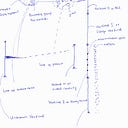Rules of the Neurons of Thoughts: Theoretical Neuroscience and Psychology
What is the cost of the mixed understanding of thoughts in mind and behavioral struggles? How helpful is conflicting thoughts with emotions and feelings? How are thoughts this central to life, yet their understanding depended on sprawling vagueness?
Neuroimaging is penetrative and incredible, but for all the types and angles, it shows no rules with which the neurons that power thoughts follow. This lack of rules complicates how to further understand psychological and psychiatry conditions.
In Thoughts: Rules of its Neurons, is a rule expression of thoughts, on how they become thoughts, their stages, where they go, where they stay and their effect across wakefulness and sleep.
If someone takes water, and as the water is on the tongue, recalls the taste of some other drink — if the drink is good, the water may feel good, but if it’s a bad drink, it ruins the likeness of that water at that moment.
This shows that there is a taste aspect of intake and there is a thought aspect. Taste is the sensory input that gets converted to thought. This thought goes to the memory, matches with that taste, then this thought goes to a location, where it points to a vertical scale to bring feelings about the intake.
Also, smell can be bad, but not often the worse feeling except it’s the worse at that moment. There may be something happy on the mind, or some fears in certain spots on the vertical that makes the bad smell feeling deprioritized.
Theoretically, to the brain, everything is interpreted as a thought to make any sense. Memory is a store that holds thoughts. Memories are simply thoughts. The memory has thought-information on everything internal and external — sensory or not.
There is physical reality like a computer on a table, which is converted to thought reality. It is this thought reality that gets stored, and if the computer is OK, there is no priority thought on it, but if it goes bad the thought reality of the computer goes to a spot of sadness in the vertical of feelings — and it could accumulate there.
Emotions are also available on that scale. Addictions are sometimes by an inconstant vertical that brings the best feeling. There is a thought box and a memory box. There is the swell, line of process, line of awareness or line of passive thoughts, the verticals and the outlets.
Each of these expresses how thoughts totalize living functionality. This model is also useful to explain memory development in childhood as well as thoughts in organisms.
The memory box has a picker and a giver. The thought box rotates and also has an individuality area, and personality group area. Thoughts are often filtered through the uniqueness of an individual. This may be similar to others in the environment resulting in personality groups, but there are no similarities for any two people.
Thoughts are not just thinking, thoughts are the process of everything, even what is called unconscious or reflex. Active and multiple passive thoughts frequently interchange, but everything processed towards an output — is a thought, and goes back to becoming an input, after which no action is taken.
Turning to look at something is a thought, or changing gaze without turning the neck is also a thought, active momentarily. This thought comes from the throwers. Though it is possible to argue that blinking is not a thought, but, blinking is a passive thought that works when the entry ports of sight is open. And that sight entry is consistently passive and may also explain its symmetry with blinking.
Explicating to someone in a crushing mental health situation of where thoughts might be or go, and the reason for certain inputs — would be further helpful at this time when uncertainties continue to drive minds adrift.
